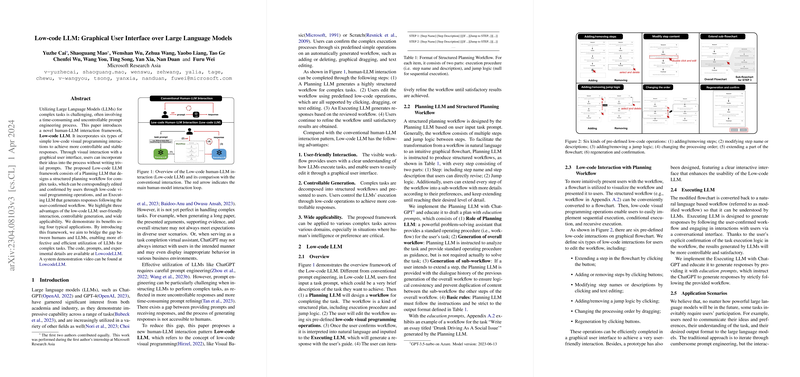Analyzing "Low-code LLM: Visual Programming over LLMs"
The paper "Low-code LLM: Visual Programming over LLMs" presents a novel framework aimed at enhancing the interactions between humans and LLMs through low-code visual programming. This approach seeks to address the complexities and inefficiencies inherent in traditional prompt engineering, particularly for tasks demanding intricate responses.
Core Framework
The proposed system, Low-code LLM, introduces a structured interaction mechanism that allows users to utilize graphical user interfaces to edit workflows through six types of low-code operations such as clicking and dragging. The framework is segmented into two primary components:
- Planning LLM: This component is responsible for designing a structured workflow for complex tasks. Users can interactively edit these workflows using low-code operations.
- Executing LLM: Following user confirmation, this component generates responses in alignment with the edited workflow.
The interaction occurs through a graphical interface, enabling users to visually manipulate the task execution without exhaustive prompt engineering. This method aims to bridge the understanding gap, making LLMs more accessible and manageable.
Advantages and Applications
The paper outlines three main advantages:
- Controllable Generation: Through the visual workflows, users gain more control over the LLM's execution processes, leading to results that align more closely with user intentions.
- User-Friendly Interaction: By shifting from text-based prompts to visual workflows, the interaction becomes more intuitive, reducing the time and effort needed for prompt engineering.
- Broad Applicability: The framework can apply to a diverse range of tasks, especially where human insight or preference plays a crucial role.
The framework's utility is demonstrated across four application domains:
- Long-content generation: Enhancing control over structure and content focus.
- Large project development: Allowing precise design input in complex development tasks.
- Task-completion virtual assistants: Minimizing risks through predefined interaction logic.
- Knowledge-embedded systems: Embedding expert insights into workflows for various domains.
Experimental Insights
The paper reports qualitative analyses demonstrating the framework's effectiveness in diverse scenarios, such as essay writing and object-oriented programming. The case studies underscore the benefits of Low-code LLM in delivering more tailored and aligned outputs compared to traditional prompt methods.
Limitations and Considerations
Despite its potential, the system introduces a cognitive load on users who must interpret and modify workflows. Additionally, the effectiveness of workflow design relies significantly on the capabilities of the Planning LLM. Users also need to possess a level of domain understanding to optimize workflow editing effectively.
Future Directions
The paper suggests promising prospects for Low-code LLM, including:
- Enhanced task automation: Integration with advances in task automation could reduce user intervention over time.
- Cross-platform integration: Potential extensions to numerous applications and tools, enhancing versatility.
- Expanded application scenarios: Applicability to an array of tasks requiring nuanced human input.
Overall, the paper sets a pathway for improved, user-centric interactions with LLMs, fostering greater accessibility and control through intuitive visual programming interfaces.
